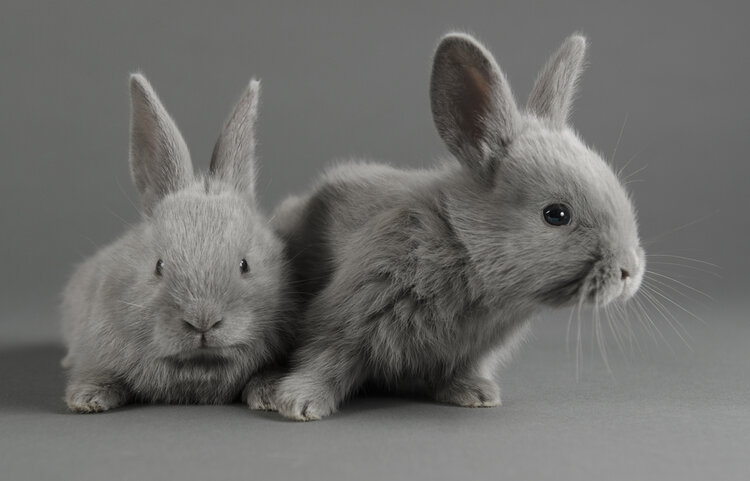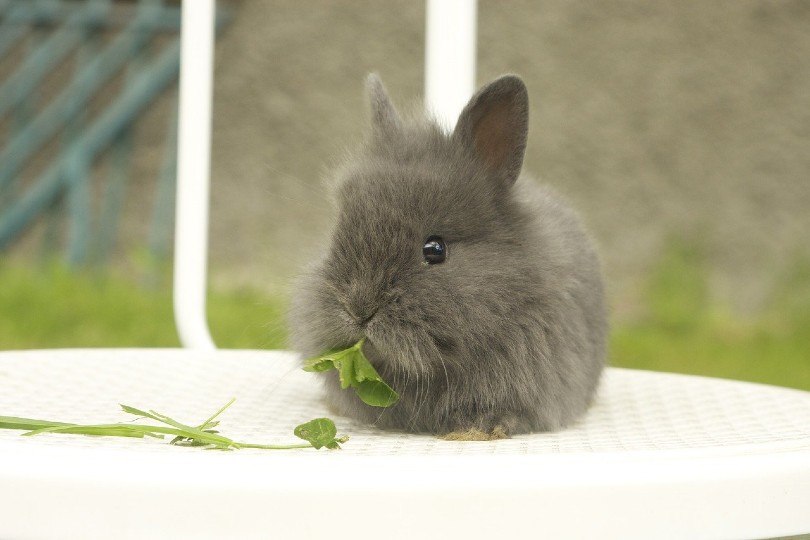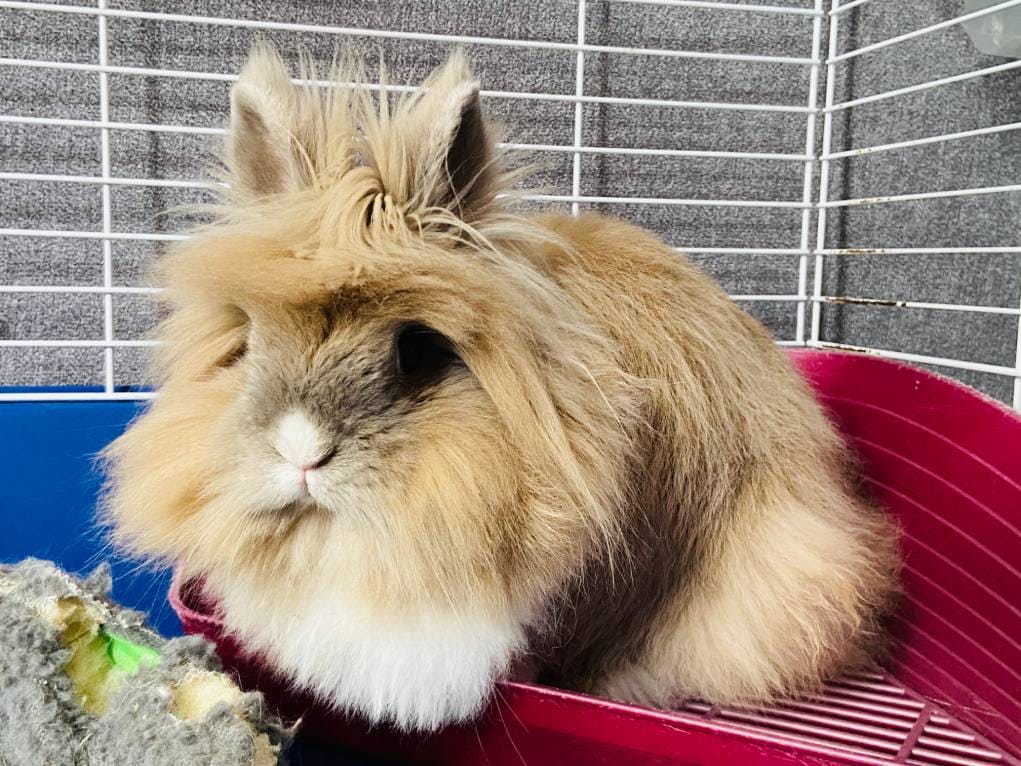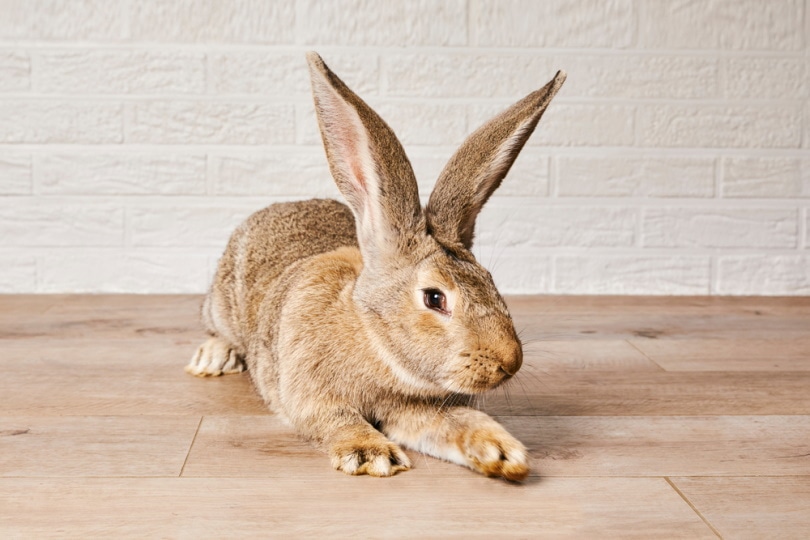
You should consider the soft, sweet Lilac rabbit if you want a cuddly bunny that will spend time with you. These rabbits have a reputation for being even-keeled and interactive with their human friends. If you were scrolling through pictures and the Lilac rabbit caught your eye, these critters are worth learning about.
Let’s go over what you can expect in terms of care. If you’re familiar with rabbits, you might not blink an eye about any requirements. You can decide whether one of these silver-blue bunnies would fare well in your home.
Quick Facts about the Lilac Rabbit

| Species Name: | Oryctolagus Cuniculus |
| Family: | Leporidae |
| Care Level: | Easy, beginner |
| Temperament: | Docile, even |
| Color Form: | Gray, pinkish-gray blue |
| Lifespan: | 8-12 years |
| Size: | 5.5-7.5 pounds |
| Diet: | Herbivore |
| Minimum Tank Size: | 48” x 48” |
| Cage Setup: | Single-level, multilevel |
| Compatibility: | High |
Lilac Rabbit Overview
The Lilac rabbit is a variation developed in captivity. They have a gorgeous bluish-gray hue, which leads to their name. Their fur’s softness translates to their personality, as these rabbits tend to be very calm and quiet creatures.
Many owners love the Lilac rabbit because they are all-around terrific to own. They are smart, receptively picking up house training (if you so choose to try) and other concepts.
The Lilac breed was formed in Great Britain during the 19th century. They didn’t make their way to the USA until 1922.
Since then, they have become a sought-after favorite.
How Much Do Lilac Rabbits Cost?
If you buy a baby Lilac bunny at a licensed breeder, you can expect to pay in the range of $20 and up. It can vary quite a bit depending on the variation and breeding quality.
You also have to consider the necessary supplies for rabbit owning, such as food, cages, bedding, and accessories. Annually, you can expect to pay around $400 for all things, not including unexpected circumstances.
Remember to keep aside a little stash in case of any emergency vet visits. Accidents can happen. Since rabbits are prey animals, they might not show signs of sickness until it’s pretty advanced.
Typical Behavior & Temperament

Getting a rabbit that you can cuddle with might be one of the necessary criteria as an owner—and this breed would be an ideal candidate. Lilac rabbits take an easy-going approach to life. These bunnies are adored for their sweet and curious demeanors.
Because of their social interaction willingness, they make perfect playmates for children and companions for older adults. You can teach them all sorts of fun tricks and let them have supervised floor time.
These rabbits do best in chaos-free environments to prevent anxiousness. Although domesticated rabbits are much more acclimated to mixed-species environments, a loud group of dogs or a house full of rambunctious kids might cause your bunny to be on edge.
If you live in a busy household, try to keep your Lilac rabbit in a quiet area. They should be fine with occasional chaos, but not if they live among it all the time.
Appearance & Varieties
The beautiful, plush Lilac rabbit has incredibly soft, plush fur and a sturdy physical structure. Many Lilac rabbits have a multicolor hue that changes in different lighting. Their hair can range from dark gray to light purple—and any color on the spectrum in between.
The Lilac rabbit is a medium-sized bunny. Females weigh between 6-8 pounds while males are a little smaller—weighing only 5.5-7.5 pounds.
How to Take Care of Lilac Rabbits
Habitat, Cage Conditions & Setup
Cage Size

Your rabbit’s cage needs to be at least four times its size. If you have multiple rabbits, the cage needs to accommodate accordingly.
For two full-grown rabbits, you will need a cage that is multilevel or singular level, at least 48” x 48”. Some owners prefer multil-evel homes for their bunnies while others swear by a single level home to make climbs easier for their little hoppers.
Multiples
Does your rabbit need a friend? Absolutely. Rabbits are highly social creatures that thrive on time spent with their own kind. Even though they can form strong bonds with humans, they need to have other rabbit friends.
Bedding
Bedding is essential, even though it might seem like a simple task. Some bedding, like cedar, contains chemicals that can be harmful to your rabbit over time.
Food & Water Dishes
Fresh water and hay should always be available in the enclosure. Make sure water is in a secured dish or water bottle, so there is no tipping possible. If the rabbit’s bedding gets too wet, it can cause upper respiratory issues.
Activities
Lilac rabbits love activities just like all bunnies. Plus, they need lots of chewable textures in their cage to file their teeth as required.
Vet Care
Your bunny needs a doctor sometimes, too. Annual checkups are ideal so you can get ahead of any developing problems. Your Lilac rabbit will require necessary vaccinations to prevent common illnesses, especially if you ever let them outdoors.
Litter Training
So, you can really litter train your rabbit? Absolutely! Some people have trained their rabbits to free-roam the house like dogs or cats. It might take some initial research and patience—but the payoff might be worth it.
Do Lilac Rabbits Get Along with Other Pets?
Because Lilac rabbits are pretty relaxed, they can do well in many multi-pet situations. They are calm and accepting, primarily when they are raised with others. So, when you bring your Lilac rabbit home, make introductions slow—and they should be best friends with your small dog or house cat.
On the opposite side of that, it’s important to remember that rabbits are technically prey animals for other house pets. Many cat and dog breeds might see the rabbit as a tasty morsel instead of a new pal. Supervise any reactions between your rabbit and other pets.
Some rodents don’t mix well. It isn’t a good idea to house your rabbit with another small pet, like a guinea pig or hamster. Also, don’t put two rabbits together that have a big age gap or size difference. You always run into the risk of injury if you try.
What to Feed Your Lilac Rabbit
Your Lilac rabbit needs a wholesome diet of nutrient-rich rabbit pellets or mix. These commercial diets cover all of the bases of prime nutrition.
Then, you can add in the necessary fiber by giving them a large stock of Timothy hay. This hay also engages your rabbit so they can naturally file their own teeth.
You should also provide lots of fresh fruits and vegetables.

Keeping Your Lilac Rabbit Healthy
Rabbit care is pretty simple once you get the hang of it. But always remember to keep your rabbit healthy by providing them with proper living conditions.
While Lilac rabbits are generally healthy creatures, they might suffer from certain ailments over others.
Keeping up with routine vet care is vital for your rabbit’s overall well-being—but so is making sure their daily living needs are met.
Breeding
If you plan to breed your Lilac rabbits, you want to keep a few things in mind first. Rabbits require specific breeding grounds and cage changes to have babies comfortably.
Vet care is incredibly crucial for moms during pregnancy. Before you breed, make sure you can commit to the appointments and costs associated with breeding.
Lilac rabbits reach sexual maturity by 4 months, but you should wait to breed until they reach 6-8 months.
Remove your bunny from the cage so she can make a nest and be alone during delivery. Mothers give birth to four to six kits at a time.
Are Lilac Rabbits Suitable For You?
If you were looking for an adorably plush, mild-tempered rabbit, the Lilac rabbit may work very well in your household. You guys can become quite close by sharing a little bowl of carrots or going out to the yard for a small adventure.
Remember that even though these rabbits are very docile, you need to make sure a child is mature enough to care for the animal. A good rule of thumb is to wait until a child is at least 6 years old before you offer them a chance to interact with the newest member of your family.
Featured Image Credit: Eloine Chapman, Shutterstock










